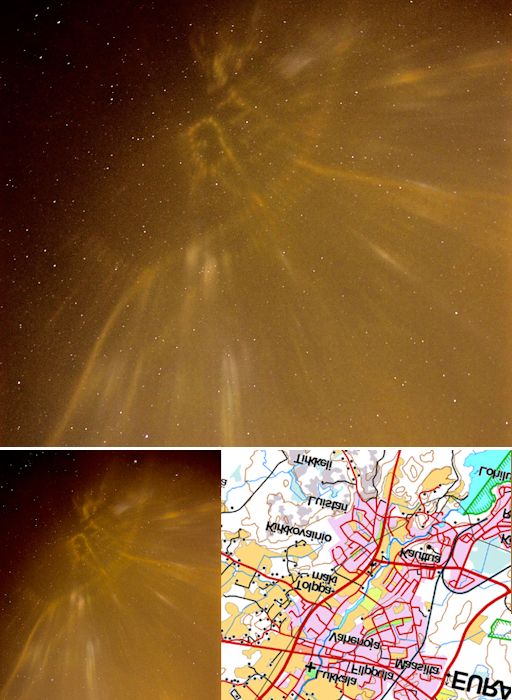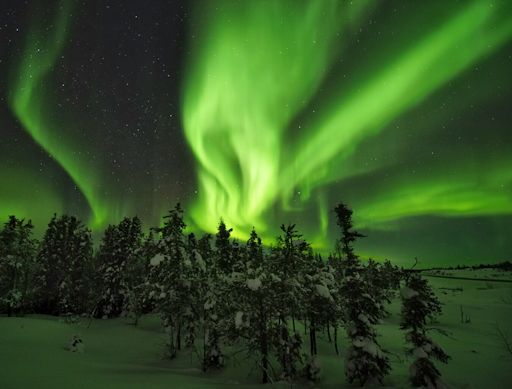Marianne's Heaven On Earth Aurora Chaser Tours Chasethelighttours.co.uk invites you to join them in their quest to find and photograph the Aurora Borealis. Experience the winter wonderland in the Tromsø Area. | | | CONTINUED QUIET: Solar activity is very low and likely to remain so for the next 24 hours. NOAA forecasters estimate a 5% chance of M-flares and no more than a 1% chance of X-flares on Jan. 14th. Solar flare alerts: text or voice. STREET MAPS IN THE SKY: Winter is unfolding around the northern hemisphere and, as temperatures drop, pillars of light are springing up from ground. Urban lights bounce off ice crystals in the air, producing luminous columns that reach into the heavens. Such "light pillars" are a common sight around northern cities in winter. On Jan. 12th, however, Mia Heikkilä looked up from her hometown in Eura, Finland, and saw something uncommon. "There was a street map of Kauttua painted in the sky!" she says. Heikkilä took this picture of the apparition: 
"It was an exact reversed light map of Kauttua, Eura, created by light pillars," Heikkilä explains. Most people see pillars from the side, where they look like luminous towers, but not Heikkilä. She was located inside a nest of pillars rising from the center of town. Looking up, she saw the tips of the pillars tracing the illuminated streets of Kauttua. In fact, the sky map was even better than the printed map Heikkilä used for comparison, because it traced the most recent changes to the cityscape. "Now I call it #LuxEura," she says. More light pillars, uncommon and otherwise, may be found in the realtime photo gallery: Realtime Spaceweather Photo Gallery MIND-ALTERING AURORAS, SUBSIDING: All week long, a stream of solar wind has gently buffeted Earth's magnetic field, sparking bright auroras around the Arctic Circle. In Yellowknife, Canada, "the display was mind-altering," reports Ryan Fisher, who took this picture on Jan. 14th: 
"It was 4 hours of crazy amazement!" he says. Earth is slowly exiting the stream of solar wind. As a result, NOAA forecasters have downgraded the chance of polar geomagnetic storms on Jan. 15th to only 20%. On the bright side, that could still produce 4 x 20% = 0.8 hours of "crazy amazement." Arctic sky watchers are advised to remain alert for auroras.. Aurora alerts: text or voice. Realtime Aurora Photo Gallery
Realtime Meteor Photo Gallery
Realtime Comet Photo Gallery
Every night, a network of NASA all-sky cameras scans the skies above the United States for meteoritic fireballs. Automated software maintained by NASA's Meteoroid Environment Office calculates their orbits, velocity, penetration depth in Earth's atmosphere and many other characteristics. Daily results are presented here on Spaceweather.com. On Jan. 14, 2016, the network reported 17 fireballs.
(17 sporadics)  In this diagram of the inner solar system, all of the fireball orbits intersect at a single point--Earth. The orbits are color-coded by velocity, from slow (red) to fast (blue). [Larger image] [movies] Potentially Hazardous Asteroids ( PHAs) are space rocks larger than approximately 100m that can come closer to Earth than 0.05 AU. None of the known PHAs is on a collision course with our planet, although astronomers are finding new ones all the time. On January 14, 2016 there were potentially hazardous asteroids. Notes: LD means "Lunar Distance." 1 LD = 384,401 km, the distance between Earth and the Moon. 1 LD also equals 0.00256 AU. MAG is the visual magnitude of the asteroid on the date of closest approach. | | Cosmic Rays in the Atmosphere | | Situation Report -- Oct. 30, 2015 | Stratospheric Radiation (+37o N) | | Cosmic ray levels are elevated (+6.1% above the Space Age median). The trend is flat. Cosmic ray levels have increased +0% in the past month. | | Sept. 06: 4.14 uSv/hr (414 uRad/hr) | | Sept. 12: 4.09 uSv/hr (409 uRad/hr) | | Sept. 23: 4.12 uSv/hr (412 uRad/hr) | | Sept. 25: 4.16 uSv/hr (416 uRad/hr) | | Sept. 27: 4.13 uSv/hr (413 uRad/hr) | | Oct. 11: 4.02 uSv/hr (402 uRad/hr) | | Oct. 22: 4.11 uSv/hr (411 uRad/hr) | These measurements are based on regular space weather balloon flights: learn more. Approximately once a week, Spaceweather.com and the students of Earth to Sky Calculus fly "space weather balloons" to the stratosphere over California. These balloons are equipped with radiation sensors that detect cosmic rays, a surprisingly "down to Earth" form of space weather. Cosmic rays can seed clouds, trigger lightning, and penetrate commercial airplanes. Our measurements show that someone flying back and forth across the continental USA, just once, can absorb as much ionizing radiation as 2 to 5 dental X-rays. Here is the data from our latest flight, Oct. 22nd: 
Radiation levels peak at the entrance to the stratosphere in a broad region called the "Pfotzer Maximum." This peak is named after physicist George Pfotzer who discovered it using balloons and Geiger tubes in the 1930s. Radiation levels there are more than 80x sea level. Note that the bottom of the Pfotzer Maximim is near 55,000 ft. This means that some high-flying aircraft are not far from the zone of maximum radiation. Indeed, according to the Oct 22th measurements, a plane flying at 45,000 feet is exposed to 2.79 uSv/hr. At that rate, a passenger would absorb about one dental X-ray's worth of radiation in about 5 hours. The radiation sensors onboard our helium balloons detect X-rays and gamma-rays in the energy range 10 keV to 20 MeV. These energies span the range of medical X-ray machines and airport security scanners. | | The official U.S. government space weather bureau | | | The first place to look for information about sundogs, pillars, rainbows and related phenomena. | | | Researchers call it a "Hubble for the sun." SDO is the most advanced solar observatory ever. | | | 3D views of the sun from NASA's Solar and Terrestrial Relations Observatory | | | Realtime and archival images of the Sun from SOHO. | | | from the NOAA Space Environment Center | | | the underlying science of space weather | | | Web-based high school science course with free enrollment | | 
